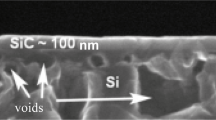Abstract
A new method for the solid-state synthesis of epitaxial layers is developed, in which a substrate participates in the chemical reaction and the reaction product grows not on the substrate surface, as in traditional epitaxial methods, but inside the substrate. This method offers new opportunities for elastic-energy relaxation due to a mechanism operating only in anisotropic media, specifically, the attraction of point defects formed during the chemical reaction. The attracting point centers of dilatation form relatively stable objects, dilatation dipoles, which significantly reduce the total elastic energy. It is shown that, in crystals with cubic symmetry, the most favorable arrangement of dipoles is the 〈111〉 direction. The theory is tested by growing silicon carbide (SiC) films on Si (111) substrates by chemical reaction with carbon monoxide CO. High-quality single-crystal SiC-4H films with thicknesses of up to 100 nm are grown on Si (111). Ellipsometric analysis showed that the optical constants of the SiC-4H films are significantly anisotropic. This is caused not only by the lattice hexagonality but also by a small amount (about 2–6%) of carbon atoms remaining in the film due to dilatation dipoles. It is shown that the optical constants of the carbon impurity correspond to strongly anisotropic highly oriented pyrolytic graphite.
Similar content being viewed by others
References
S. J. Pearton, Wide Bandgap Semiconductors: Growth, Processing and Applications (William Andrew, Noges, New York, 2000).
Jianwei Wan, Heteroepitaxy of Wide Band Gap Semiconductorson Silicon Substrates (VDM, Saarbrüken, 2009).
L. Liu and J. H. Edgar, Mater. Sci. Eng. R 37, 61 (2002).
S. A. Kukushkin and A. V. Osipov, Phys. Usp. 41, 983 (1998).
R. Siems, Phys. Status Solidi 30, 645 (1968).
J. D. Eshelby, Acta Met. 3, 487 (1955).
S. A. Kukushkin and A. V. Osipov, J. Appl. Phys. 113, 024909 (2013).
S. A. Kukushkin and A. V. Osipov, Dokl. Phys. 57, 217 (2012).
S. A. Kukushkin and A. V. Osipov, Izv. Akad. Nauk, Mekh. Tverd. Tela, No. 2, 122 (2013).
I. M. Lifshits and L. N. Rozentsveig, Zh. Eksp. Teor. Fiz. 17, 783 (1947).
J. W. Christian, The Theory of Transformations in Metals and Alloys (Pergamon, Amsterdam, 2002).
Author information
Authors and Affiliations
Corresponding author
Additional information
Original Russian Text © S.A. Kukushkin, A.V. Osipov, 2013, published in Fizika i Tekhnika Poluprovodnikov, 2013, Vol. 47, No. 12, pp. 1575–1579.
Rights and permissions
About this article
Cite this article
Kukushkin, S.A., Osipov, A.V. Anisotropy of the solid-state epitaxy of silicon carbide in silicon. Semiconductors 47, 1551–1555 (2013). https://doi.org/10.1134/S1063782613120129
Received:
Accepted:
Published:
Issue Date:
DOI: https://doi.org/10.1134/S1063782613120129




